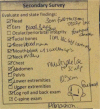Checklist as a Memory Externalization Tool during a Critical Care Process
- PMID: 28269905
- PMCID: PMC5333210
Checklist as a Memory Externalization Tool during a Critical Care Process
Abstract
We analyzed user interactions with a paper-based checklist in a regional trauma center to inform the design of digital cognitive aids for safety-critical medical teamwork. An initial review of paper checklists from actual trauma resuscitations revealed that trauma team leaders frequently wrote notes on the checklist. To understand this notetaking practice, we performed content analysis of 163 checklists collected over the period of four months. We found nine major categories of information that leaders recorded during resuscitations, including patient values, physical assessment findings, and pre-hospital information. An analysis of types and amount of notes written by leaders of different experience levels showed that more experienced leaders recorded more patient values and physical findings, while less experienced leaders recorded more notes about their activities and task completion status. These findings suggested that a checklist designed for a high-risk, fast-paced medical event has evolved into a dual function tool, serving both as a compliance and memory aid. Based on these findings, we derived requirements for designing digital cognitive aids to support safety-critical medical teamwork.
Figures









Similar articles
-
The Ryder Cognitive Aid Checklist for Trauma Anesthesia.Anesth Analg. 2016 May;122(5):1484-7. doi: 10.1213/ANE.0000000000001186. Anesth Analg. 2016. PMID: 27101496
-
Effect of a checklist on advanced trauma life support task performance during pediatric trauma resuscitation.Acad Emerg Med. 2014 Oct;21(10):1129-34. doi: 10.1111/acem.12487. Acad Emerg Med. 2014. PMID: 25308136
-
Design Challenges in Converting a Paper Checklist to Digital Format for Dynamic Medical Settings.Int Conf Pervasive Comput Technol Healthc. 2016 May;2016:33-40. Epub 2016 Jun 16. Int Conf Pervasive Comput Technol Healthc. 2016. PMID: 28480116 Free PMC article.
-
Effects of the application of a checklist during trauma resuscitations on ATLS adherence, team performance, and patient-related outcomes: a systematic review.Eur J Trauma Emerg Surg. 2020 Feb;46(1):65-72. doi: 10.1007/s00068-019-01181-7. Epub 2019 Aug 7. Eur J Trauma Emerg Surg. 2020. PMID: 31392359 Free PMC article.
-
The Development and Implementation of Cognitive Aids for Critical Events in Pediatric Anesthesia: The Society for Pediatric Anesthesia Critical Events Checklists.Anesth Analg. 2017 Mar;124(3):900-907. doi: 10.1213/ANE.0000000000001746. Anesth Analg. 2017. PMID: 28079584 Review.
Cited by
-
Analysis of Task Attributes Associated with Crisis Checklist Compliance in Pediatric Trauma Resuscitation.AMIA Annu Symp Proc. 2024 Jan 11;2023:504-513. eCollection 2023. AMIA Annu Symp Proc. 2024. PMID: 38222377 Free PMC article.
-
Exploring Design Opportunities for a Context-Adaptive Medical Checklist Through Technology Probe Approach.DIS (Des Interact Syst Conf). 2017 Jun;2017:57-68. doi: 10.1145/3064663.3064715. DIS (Des Interact Syst Conf). 2017. PMID: 30381804 Free PMC article.
-
Getting ON-TRAC, a team-centred design study of a reflexivity aid to support resuscitation teams' information sharing.Adv Simul (Lond). 2025 Mar 28;10(1):17. doi: 10.1186/s41077-025-00340-8. Adv Simul (Lond). 2025. PMID: 40156074 Free PMC article.
-
Understanding Digital Checklist Use Through Team Communication.Ext Abstr Hum Factors Computing Syst. 2020 Apr;2020:10.1145/3334480.3382817. doi: 10.1145/3334480.3382817. Ext Abstr Hum Factors Computing Syst. 2020. PMID: 32747878 Free PMC article.
-
Supporting Awareness of Dynamic Data: Approaches to Designing and Capturing Data within Interactive Clinical Checklists.DIS (Des Interact Syst Conf). 2023 Jul;2023:1293-1308. doi: 10.1145/3563657.3595979. Epub 2023 Jul 10. DIS (Des Interact Syst Conf). 2023. PMID: 40589879 Free PMC article.
References
-
- Haynes AB, Weiser TG, Berry WR, Lipsitz SR, Breizat AHS, Dellinger EP, et al. A surgical safety checklist to reduce morbidity and mortality in a global population. N Engl J Med. 2009;360:491–9. - PubMed
-
- Holzmueller CG, Timmel J, Kent PS, Schulick RD, Pronovost PJ. Implementing a team-based daily goals sheet in a non-ICU setting. Jt Comm J Qual Patient Saf. 2009;35(384-8):341. - PubMed
-
- Stahl KD, Brien SE. Reducing patient errors in trauma care. In: Cohn SM, editor. Acute Care Surgery and Trauma Care. London, UK: Informa Health Care; 2009. pp. 268–277.
MeSH terms
LinkOut - more resources
Full Text Sources
Medical
